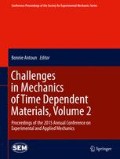Abstract
Many materials are multiphasic, with an evolving, transient microstructure. If load-bearing phases within such a material dissolve while the material is under load, the stress being transmitted by those phases is handed off to neighboring phases, which leads to additional deformation. Thus, time-dependent dissolution results in creep or relaxation of the macroscopic material. To mechanistically model such dissolution-induced creep or relaxation, it is necessary to couple a model of the microstructure with the evolving states of stress and strain within the material. Here, we discuss a computationally-implemented model where creep or relaxation of an evolving composite is attributable to dissolution. Special care is taken in tracking the natural configuration of each voxel of the multiphasic material such that newly precipitated phases form in a stress-free state. The new model is utilized to model (1) relaxation of a porous material that has melting ice within its pore network and (2) relaxation due to hydration-induced dissolution within cement paste.
Access this chapter
Tax calculation will be finalised at checkout
Purchases are for personal use only
Notes
- 1.
Apparent strain is defined here, from a continuum mechanics perspective, as strain that exists independent of the state of stress. Unlike other ‘free’ strains (e.g., strain induced by changes in temperature or moisture state of the material), the apparent strain here does not involve a change in the atomic or molecular spacing from the reference configuration. However, from a book-keeping perspective, apparent strain is treated in the same fashion as free strains.
- 2.
This solution procedure for the VE/VP material problem disregards any linear momentum in the body. This approach generates negligible error since the velocity of the time-dependent deformation is extremely slow under the boundary conditions considered.
References
M. Suter, G. Benipal, Constitutive model for aging thermoviscoelasticity of reacting concrete I: theoretical formulation. Mech. Time-Depend. Mater. 14, 277–290 (2010)
O.M. Jensen, P.F. Hansen, Autogenous deformation and change of the relative humidity in silica fume-modified cement paste. ACI Mater. J. 93, 539–543 (1996)
B.T. Tamtsia, J.J. Beaudoin, Basic creep of hardened cement paste. A re-examination of the role of water. Cem. Concr. Res. 30, 1465–1475 (2000)
X. Li, Z.C. Grasley, E.J. Garboczi, J.W. Bullard, Modeling the apparent and intrinsic viscoelastic relaxation of hydrating cement paste. Cem. Concr. Compos. 55, 322–330 (2015)
X. Li, Z.C. Grasley, E.J. Garboczi, J.W. Bullard, Computing the time evolution of the apparent viscoelastic/viscoplastic Poisson’s ratio of hydrating cement paste. Cem. Concr. Compos. 56, 121–133 (2015)
W. Ruetz, A hypothesis for the creep of hardened cement paste and the influence of simultaneous shrinkage, Proceedings of International Conference on the Structure of Concrete, (1968)
T.I. Zohdi, Homogenization Methods and Multiscale Modeling (Wiley, Chichester, 2004)
R.B. Bohn, E.J. Garboczi, User Manual for Finite Element and Finite Difference Programs: A Parallel Version of NISTIR-6269, U.S. Department of commerce, Technology Administration, National Institute of Standards and Technology, Information Technology Laboratory, Building and Fire Research Laboratory, (2003)
C.J. Haecker, E.J. Garboczi, J.W. Bullard, R.B. Bohn, Z. Sun, S.P. Shah, T. Voigt, Modeling the linear elastic properties of Portland cement paste. Cem. Concr. Res. 35, 1948–1960 (2005)
E.J. Garboczi, A.R. Day, An algorithm for computing the effective linear elastic properties of heterogeneous materials: three-dimensional results for composites with equal phase Poisson ratios. J. Mech. Phys. Solids 43, 1349–1362 (1995)
S.P. Timnoshenko, J.N. Goodier, Theory of Elasticity (McGraw-Hill, New York, 1970)
P.V. Hobbs, Ice Physics (Oxford University Press, Oxford, 2010)
S. Rahman, Z. Grasley, A poromechanical model of freezing concrete to elucidate damage mechanisms associated with substandard aggregates. Cem. Concr. Res. 55, 88–101 (2014)
C.K. Leung, Z.C. Grasley, Poromechanical damping of cementitious materials. J. Mater. Civil Eng. 24, 232–238 (2012)
C.A. Jones, Z.C. Grasley, Correlation of radial flow-through and hollow cylinder dynamic pressurization test for measuring permeability. J. Mater. Civil Eng. 21, 594–600 (2009)
C.A. Jones, Z.C. Grasley, Correlation of hollow and solid cylinder dynamic pressurization tests for measuring permeability. Cem. Concr. Res. 39, 345–352 (2009)
C.A. Jones, Z.C. Grasley, Novel and flexible dual permeability measurement device for cementitious materials. ACI Mater. J. 106, 192–197 (2009)
C.A. Jones, Z.C. Grasley, Measuring Concrete Permeability Using Dynamic Pressurization: Achieving Saturation, 2009 NRMCA Concrete Technology Forum, (electronic proceedings) T05.2, (2009)
L.D. Landau, E.M. Lifshitz, Theory of elasticity, 3rd edn. (Pergamon Press, Oxford, 1986)
D. Bentz, E. Garboczi, K. Snyder, Hard core/soft shell microstructural model for studying percolation and transport in three-dimensional composite media. NISTIR 55, 62–65 (1999)
A. Yazdanbakhsh, Production, characterization, and mechanical behavior of cementitious materials incorporating carbon nanofibers. (Texas A&M University, 2012)
J.W. Bullard, B. Lothenbach, P.E. Stutzman, K.A. Snyder, Coupling thermodynamics and digital image models to simulate hydration and microstructure development of Portland cement pastes. J. Mater. Res. 26, 609–622 (2011)
B. Lothenbach, F. Winnefeld, Thermodynamic modelling of the hydration of Portland cement. Cem. Concr. Res. 36, 209–226 (2006)
L. Parrot, D. Killoh, Prediction of cement hydration. Proc. Br. Ceram. Soc. 35, 41–53 (1984)
Acknowledgments
This research was supported by the National Science Foundation CAREER Award Program under grant number CMMI-0843979. Any opinions, findings, and conclusions or recommendations expressed in this material are those of the author(s) and do not necessarily reflect the views of the National Science Foundation.
Author information
Authors and Affiliations
Corresponding author
Editor information
Editors and Affiliations
Rights and permissions
Copyright information
© 2016 The Society for Experimental Mechanics, Inc.
About this paper
Cite this paper
Li, X., Rahman, S., Grasley, Z.C. (2016). Modeling Creep and Relaxation Caused by Phase Dissolution. In: Antoun, B. (eds) Challenges in Mechanics of Time Dependent Materials, Volume 2. Conference Proceedings of the Society for Experimental Mechanics Series. Springer, Cham. https://doi.org/10.1007/978-3-319-22443-5_9
Download citation
DOI: https://doi.org/10.1007/978-3-319-22443-5_9
Publisher Name: Springer, Cham
Print ISBN: 978-3-319-22442-8
Online ISBN: 978-3-319-22443-5
eBook Packages: EngineeringEngineering (R0)

